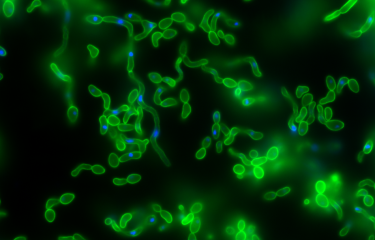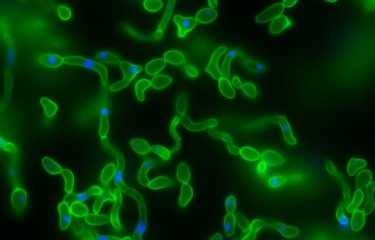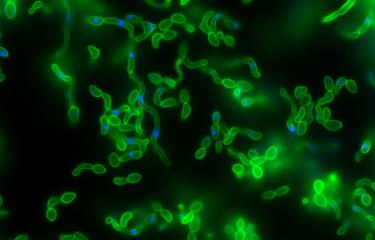Candida albicans is a yeast that naturally resides in the human intestinal tract, but which can prove to be a formidable pathogen in the event of a drop in the host's immune defences, responsible for superficial or generalised ailments, sometimes fatal. A research group including researchers from the Institut Pasteur has studied the morphological mechanisms facilitating infection by C. albicans.
One of the mechanisms facilitating the infectious process of C. albicans is its ability to alternate between several morphologies depending on its environment. Among the morphologies adopted, large spherical cells called chlamydospores appear in very particular conditions (at 25 degrees Celsius, in the dark, and in conditions of nutritional deficiency). Although they were identified at the end of the 19th century, the mechanisms governing their formation remain unknown, as does their role.
The protein Rme1 is a central regulator of chlamydospore formation.
Researchers have identified the central regulator of chlamydospore formation, the protein Rme1. While differentiation into chlamydospores is normally induced by the above-mentioned environmental factors, overexpression of this protein induces differentiation independently of these signals. Interestingly, Rme1 expression is initially induced by environmental signals, but once triggered, it is self-sustaining: Rme1 expression becomes independent of the environment and is controlled by the Rme1 protein itself. A C. albicans mutant that no longer produces the Rme1 protein is unable to differentiate into chlamydospores.
"We have identified the regulatory network that depends on Rme1 and were able to show that the expression of chlamydospore-specific proteins is directly controlled by this protein," explains Christophe d'Enfert, head of the Fungal Biology and Pathogenicity Unit and Scientific Director of the Institut Pasteur.
The identification of the central regulator of this process is the first step towards understanding the molecular mechanisms at the origin of the formation of these cells, and their role in the biology of C. albicans.
Source:
A conserved regulator controls asexual sporulation in the fungal pathogen Candida albicans, nature communications, 4 december 2020. DOI: https://doi.org/10.1038/s41467-020-20010-9
Arturo Hernández-Cervantes1,13, Sadri Znaidi 1,2,3, Lasse van Wijlick 1, Iryna Denega 1,4,
Virginia Basso 1,4,14, Jeanne Ropars 1,15, Natacha Sertour1, Derek Sullivan 5, Gary Moran5,
Louise Basmaciyan6,7, Fabienne Bon6, Frédéric Dalle6,7, Marie-Elisabeth Bougnoux1,8, Teun Boekhout 9,10,
Ying Yang11, Zongwei Li12, Sophie Bachellier-Bassi 1 & Christophe d’Enfert 1
1 Unité Biologie et Pathogénicité Fongiques, Institut Pasteur, USC, 2019 INRA Paris, France.
2 Institut Pasteur de Tunis, Laboratoire de Microbiologie
Moléculaire, Vaccinologie et Développement Biotechnologique, Bâtiment Etienne Burnet, 13 Place Pasteur, B.P.74, 1002 Tunis-Belvédère, Tunisia.
3 University of Tunis-El Manar, 1036 Tunis, Tunisia.
4 Université de Paris, Sorbonne Paris Cité, Paris, France.
5 Dublin Dental University Hospital and School of Dental Science, Trinity College Dublin, Dublin 2, Ireland.
6UMR PAM, Université de Bourgogne Franche-Comté, AgroSup Dijon – Equipe VAIMiS, Dijon, France.
7 Centre Hospitalier Universitaire François Mitterand, Service de Parasitologie Mycologie, Dijon, France.
8 Unité de Parasitologie-Mycologie, Service de Microbiologie clinique, Hôpital Necker-Enfants-Malades, Assistance Publique des Hôpitaux de Paris (APHP), Université de Paris, Paris, France.
9 Westerdijk Fungal Biodiversity Institute, Utrecht, The Netherlands.
10 Institute of Biodiversity and Ecosystem Dynamics (IBED), University of Amsterdam, Amsterdam, The Netherlands.
11 Beijing Institute of Radiation Medicine, Beijing 100850, China.
12 Center for Hospital Infection Control, Institute for Disease Control & Prevention, Beijing 100071, China.
13Present address: Université de Paris / Inserm, 1 Avenue Claude Vellefaux, F-75010 Paris, France.
14Present address: Department of Pathology and Laboratory Medicine, Norris Comprehensive Cancer Center, Keck School of Medicine, University of Southern California, Los Angeles, CA, USA.
15Present address: Université Paris-Saclay, CNRS, AgroParisTech, Écologie, Systématique, Évolution, F-91405 Orsay, France.






